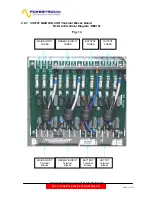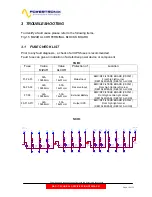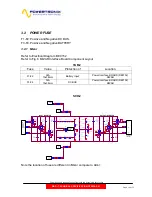
R&D – TECHNICAL SPECIFICATION DT0424-E01
Powertronix spa reserves the right to modify this document without notice
Page
.
4 of 73
WARNING !
The following documentation requires the knowledge and the support of Mizar-Alcor
USER MANUAL .
1. GENERAL ITEMS
1.1 INTRODUCTION
The UPS contains complex electronic control circuits which require a firm understanding
in order to carry out comprehensive fault diagnosis and repair of the equipment.
The aim of the information contained in this chapter is to provide sufficient guidance to
the trained service engineer, to enable successful fault location to printed circuit board
level. When a faulty circuit board or component has been identified, it should be replaced
or returned to the nearest service centre to repair.
The troubleshooting information include the following items :
•
Component location and identification
•
Diagnostic
information
•
Troubleshooting
procedures
•
Test procedures
Note: when following the procedures cross referencing is inevitable, therefore
it is recommended that this chapter is read in its’ entirety, before commencing
work on the equipment.
There is no practical way detecting an impending UPS malfunction, as most problems do
not emerge as a gradual performance degradation. Generally the UPS will either work
correctly or shut down with or without a warning indication.
In the event of a UPS malfunction troubleshooting should be carried out methodically
along the following guide lines.
1.1.1 General Fault Identification Procedure
When first summoned to the UPS fault the immediate action should be to observe and
record the LED indication displayed on the unit operator panel.
a) Determine the UPS power status.
b) Note the control switch configuration, and also the warning horn sequence if it is
operating.
WARNING: during the troubleshooting it will be necessary to power up the
unit whit the side or top covers removed. In this situation exposure
to potentially lethal voltage is possible even whit the input utility
supply switched off.
Take great care at all switch to minimize the risk of contact whit live
voltage, especially when working around the battery or DC bus





































